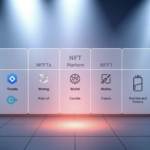Now Reading: Discover AI Powered Crypto Payment Processing Solutions
- 01
Discover AI Powered Crypto Payment Processing Solutions
Discover AI Powered Crypto Payment Processing Solutions

Modern digital payments combine smart models and distributed ledgers to make transactions faster, cheaper, and more transparent.
Today’s systems inspect transaction streams in real time to spot anomalies and stop fraud before losses occur. Blockchain brings verifiable records and traceability, while smart contracts lower settlement costs compared with legacy rails.
Users and businesses gain smoother authorization flows that preserve human control through layered oversight. Regulators in the US and EU stress transparency, fairness, data protection, and clear risk management as adoption grows.
The report previews programmable settlement engines that route payments across the best rail by fees, timing, and risk. It also maps an expanding ecosystem of platforms and merchants working on common standards to boost trust and interoperability.
For a deeper look at secure wallets that tie into this shift, see trusted wallet approaches.
Key Takeaways
- Smart analytics and distributed ledgers modernize payments while raising baseline security.
- Real-time fraud detection reduces losses and improves compliance outcomes.
- Programmable settlement can cut costs and optimize routing across rails.
- Regulatory focus requires transparency, data protection, and human oversight.
- Interoperable standards help the ecosystem scale safely for users and businesses.
The present landscape of digital payments and crypto in the United States
In the U.S., digital wallets and contactless checkout moved from novelty to everyday habit for many consumers.
Mobile wallets like Apple Pay and Google Wallet sped adoption by making checkout seamless across apps and stores. At the start of 2024 there were roughly 13,100 FinTech companies, and the global FinTech market showed strong growth from about $79.38B in 2023 toward larger forecasts.
Market momentum: From wallets to mainstream payments
The rise of digital payments reflects convenience, better UX, and faster time-to-cash. Software-driven payment systems shorten settlement windows and improve dispute workflows for consumers.
Cryptocurrency and cryptocurrencies brought peer-to-peer settlement and programmable money. These features add transparency and immutability through blockchain while integrating into existing rails.
Ecosystem forces: Platforms, banks, and users
Platforms play a large role in distribution, risk tooling, and orchestration. Banks focus on compliance and custody while FinTechs push feature velocity and UX innovation.
- FinTech expansion fuels product diversity and industry scale.
- Users and consumers expect instant confirmations and clear fees.
- Next phase: hybrid flows that combine card, ACH, bank transfers, and crypto settlement.
Regulatory visibility keeps innovation grounded—oversight aims to secure fair access, safety, and robust risk controls as the ecosystem evolves.
How AI and blockchain are redefining payment systems in real time
Immutable ledgers and fast decision engines now verify and route funds as they move across networks. This blend of blockchain and modern technology upgrades data provenance, so ledger entries remain traceable and tamper-resistant across counterparties.

Blockchain integrity and smart contracts for automated, low-cost transactions
Smart contracts automate fulfillment rules and cut intermediaries. They reduce settlement delays, lower reconciliation work, and scale complex payments like subscriptions or marketplace payouts.
Analytics powering personalization and user experiences
Analytics and contextual models profile transactions, detect anomalies, and tailor checkout flows. Adaptive risk scoring and merchant-category detection boost first-pass approvals and reduce friction for end users.
Programmable assets and routed settlements across platforms
Programmable assets enable conditional releases, escrow-like holds, and split settlements without manual steps. Hybrid engines mix deterministic rules with machine learning to pick optimal routes, trimming costs and latency while keeping audit trails intact.
These patterns let platforms run metered services, subscriptions, and partner payouts with greater speed and trust, and they form practical, auditable solutions for today’s payments systems.
Security, fraud detection, and risk management in AI-led transactions
Payment platforms now fuse device fingerprints and behavioral baselines to assign risk scores in milliseconds. These scores combine merchant context, device signals, and historical behavior to assess authorization risk before a transaction clears.

Real-time scoring and layered defenses
Systems apply supervised models plus rule engines to cut false positives while blocking coordinated fraud. This layered approach balances automation with human review for flagged cases.
Privacy and data protection
Privacy by design means data minimization, encryption in transit and at rest, and strict access control. These practices reduce identity theft and keep sensitive records safe.
Containment, auditability, and human control
Mandates like rate limits, scoped model permissions, and policy checks help stop rogue model behavior. Immutable ledgers and detailed logs give traceability from intent to settlement, strengthening trust across acquirers and merchants.
| Capability | Primary Benefit | Operational Control |
|---|---|---|
| Real-time scoring | Faster fraud detection | Pre-authorization hold / human review |
| Layered models + rules | Fewer false positives | Model governance and refresh cycles |
| Privacy controls | Lower identity theft risk | Encryption, data minimization |
| Incident runbooks | Rapid containment | Key rotation, quarantine, escalation |
Ongoing risk assessments, explainability checks, and human-in-the-loop review align controls with regulatory expectations. Together, these steps strengthen security and build trust in payments systems.
Compliance, transparency, and human oversight in financial services
Clear governance and traceable decisions are becoming the baseline for modern financial services. Regulators in the US and EU expect firms to show accountability, fairness, and strong risk controls where automated systems touch funds.
Regulatory priorities across the US and EU
Supervisors focus on three themes: clear accountability, demonstrable fairness, and effective risk management. Financial institutions must document model behavior, data sources, and decision factors to build trust with examiners and customers.
Operational controls and advanced authorization
Businesses embed human oversight with threshold rules that route high-value or unusual transactions to manual review. Controls include step-up authentication, multi-party approvals, and policy checks that gate final release.

| Control | Primary Benefit | Evidence for Audits |
|---|---|---|
| Step-up authentication | Reduces fraud on large transfers | Logs, challenge responses |
| Multi-party approvals | Shared responsibility | Approval trails, timestamps |
| Explainable models | Transparent decisions | Model reports, feature importance |
| Data retention policies | Meets privacy obligations | Policy documents, deletion logs |
To prepare for exams, firms should map roles between merchants, processors, and platforms, keep policy inventories, and retain testing evidence. These steps lower ambiguity in incident ownership and help maintain compliant payments systems.
Agentic payments infrastructure: Google’s AP2 and the x402 crypto extension
Google’s Agent Payments Protocol (AP2) establishes a shared foundation that standardizes agent-led orchestration across banks, merchants, and platforms. Sixty-plus organizations helped design the open protocol to reduce fragmentation and speed interoperability.

Mandates and verifiable credentials
Mandates act as tamper-proof digital contracts anchored by verifiable credentials. They prove authorization and authenticity and scope what an agent may do.
Human-present versus delegated purchases
The human-present flow uses an Intent Mandate to capture context and a Cart Mandate to lock items and price. This chain makes sure users pay for exactly what they approved.
Delegated flows let a pre-approved Intent Mandate set limits. An agent can then form a Cart Mandate when conditions match the mandate.
Accountability and rails
Non-repudiable audit trails link intent, cart, and funding so each transaction is traceable. AP2 supports cards, debit, stablecoins, cryptocurrencies, and real-time bank transfers to maximize reach and conversion.
- Security and trust: cryptographic signatures and clear authority scopes.
- Ecosystem: networks, processors, and commerce platforms collaborate via a common rulebook and a GitHub repo with specs and refs.
- x402 extension: enables agent-based crypto transaction flows for production-grade deployments.
Where AI-powered crypto payments create value today
Across industries, modern rails combine ledger integrity and adaptive detection to cut costs and speed transfers. These applications improve how funds move, who can access them, and how risks are managed.
Banking, remittances, and cross-border flows
Smart contracts automate corridors that lower fees and speed settlement for cross-border transactions.
JPMorgan’s Onyx (Kinexys) supports real-time, multicurrency transfers and programmable instructions for banks and platforms.
Fraud detection, healthcare claims, and gig disbursements
Adaptive models reduce false declines while blocking sophisticated attacks across healthcare and marketplaces.
Finastra’s automation shows how anomaly detection plus ledger speed improves reconciliation and trust.
Small businesses and consumers: lower costs, faster settlement, more control
Square blends personalization with ledger-backed records so small businesses grow with less overhead.
Consumers see clearer fees, faster refunds, and options to split or schedule transfers.
| Use Case | Primary Benefit | Example Provider | Key Feature |
|---|---|---|---|
| Cross-border remittances | Lower fees, faster settlement | JPMorgan Onyx (Kinexys) | Programmable routing |
| Healthcare payouts | Fewer errors, secure records | Finastra | Anomaly detection + ledger |
| Gig economy disbursements | Near-instant access, configurable splits | Platform integrations | Programmable rails |
| Small business receipts | Higher approvals, easier reconciliation | Square | Personalization + blockchain records |
AI powered crypto payment processing solutions
Orchestration platforms tie together step-up verification, credential tokens, and least-privilege agent scopes to protect users while improving conversion.
Building blocks include adaptive scoring services, blockchain settlement layers, orchestration engines, and mandate contracts that record consent and authority.
Reference architectures pair step-up verification with tokenized credentials and narrow agent scopes. This model reduces fraud and keeps human control where regulators require it.
- Multi-method checkout: route cards, bank rails, or stablecoin rails by cost, latency, and risk.
- Security controls: continuous authentication, device intelligence, and post-authorization monitoring to stop lateral attacks.
- Data and analytics: real-time pipelines feed decisioning while preserving privacy and audit records.
| Component | Benefit | Operational Pattern |
|---|---|---|
| Scoring service | Faster risk decisions | Streamed models + explainability |
| Settlement layer | Verifiable finality | Tokenized ledger entries |
| Orchestration | Optimal routing | Rule engine + dynamic routing |
| Mandate contracts | Clear consent | Revocation + audit trail |
Design patterns for merchants cover dispute automation, automated payouts, and subscription management. For integration, use robust APIs, event streams, and idempotent handlers. To learn more about practical integration and governance, see ai and blockchain integration.
Navigating what’s next: Strategic moves for US businesses and institutions
A practical roadmap helps businesses link user experiences across channels while keeping control and compliance intact.
Prioritize clear consent, robust security, and measurable trust outcomes when unifying digital payment experiences. Invest in data foundations and model governance so transactions run reliably and meet regulator expectations.
Pilot AP2/x402 mandate flows and open standards to reduce disputes and boost transparency across payment systems. Expand crypto readiness where cryptocurrencies cut costs, but keep treasury guardrails and compliance in place.
Build smart contracts and tokenized assets for new applications like escrow and programmable payouts. Strengthen privacy, fraud detection, and incident playbooks to protect users and maintain smooth experiences.
In short: fund controlled pilots, align with financial institutions and platforms, and favor open specs to speed adoption. That approach helps businesses prepare for the future while preserving trust and clear accountability.















